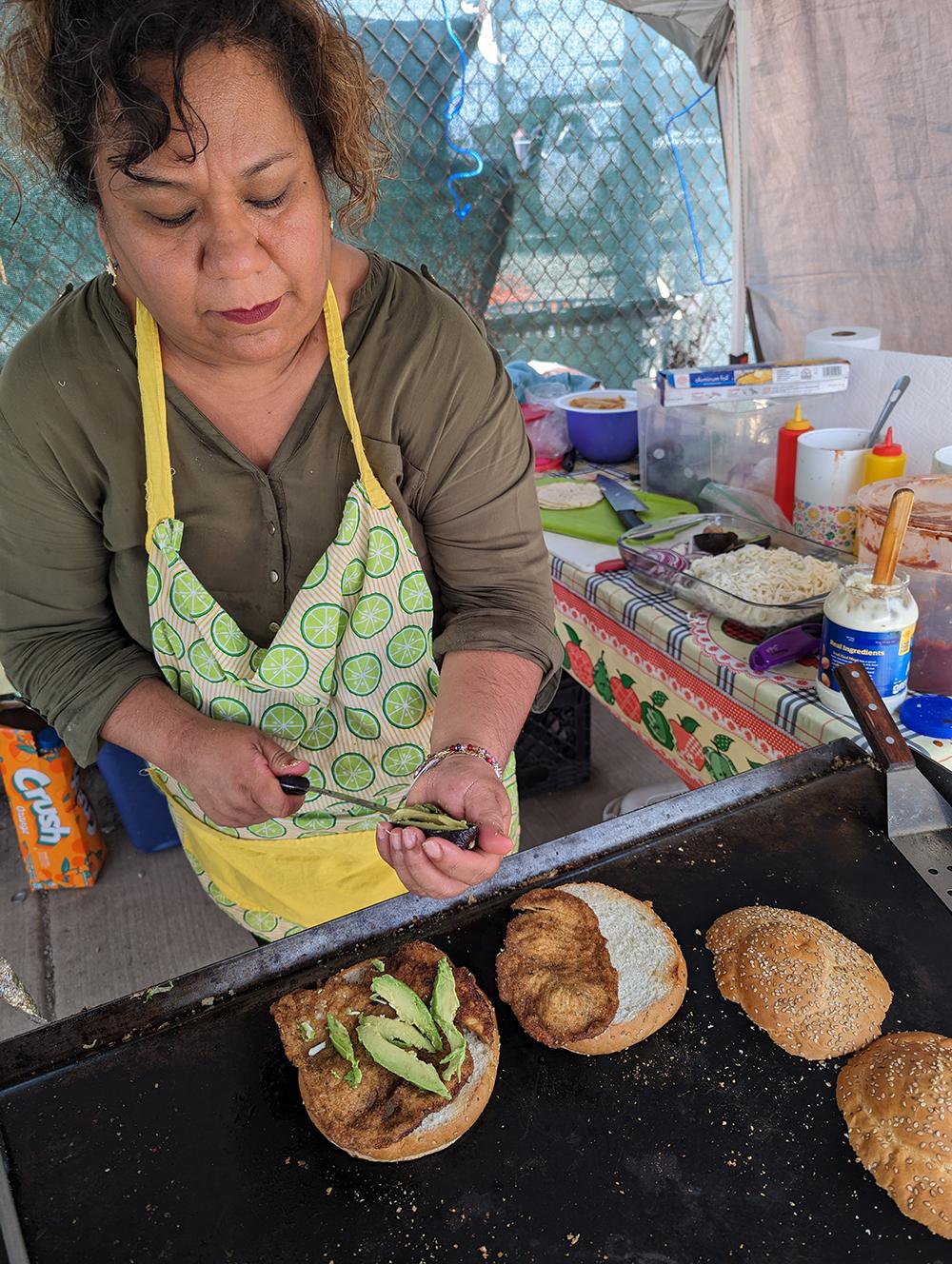A Guide to Exploring the Latino Flavors at a Back of the Yards Flea Market
Lisa Futterman
May 18, 2023

Get more recipes, food news, and stories by signing up for our Deep Dish newsletter.
On weekends at the food stalls surrounding the Swap-O-Rama Flea Market in Chicago’s Back of the Yards neighborhood, the accepted currency is dollars, but the language and flavors are distinctly Latino.
According to their website, Swap-O-Rama launched in the Midwest in 1973, then opened the “granddaddy of all flea markets” in their current location at 41st and Ashland in 1992. For just a $2.00 admission, visitors can shop endless indoor aisles of bikes, socks, tchotchkes, and power tools. Browsing the flea can be fun, but strolling the food stands outside the perimeter of the parking lot, starting behind the McDonald’s at 42nd and Marshfield and continuing down 43rd Street towards Western Avenue, reveals the diversity and variety of Chicago’s Mexican street food. When you look up and see towering stacks of shipping containers, you’ve arrived at snack central.
The ever-shifting and changing line up of vendors offer an incredible array of items to eat and drink. The stalls are cash-only, but don’t worry if your Spanish is rusty—the sellers are warm and welcoming throughout. Many of the stalls offer seating and informal table service.
The selection rivals street vendor hubs like the Chilpanchingo metro stop in Mexico City, where some of the finest street food in the Mexican capital is found. Name your favorite Latino snack. Flautas? Check. Tortas? Check. Tacos de carnitas? Check.
Tacos are offered with dozens of fillings, from carne asada to cabeza and everything in between.
If you regularly make quesadillas at home, you may not recognize the versions presented on 43rd street. Fashioned from giant, freshly-pressed corn tortillas and caramelized on a hot comal, they come packed with interesting seasonal ingredients like flor de calabaza (squash blossoms) and trendy quesabirria (a rich blend of chile-braised beef and cheese).
The market showcases foods rarely found elsewhere in Chicago. Tlacoyos, for example, are oval-shaped masa boats filled with beans and cheese. Pescadillos—crunchy, deep-fried corn tortillas filled with a tasty mix of flaked fish and herbs and secured with toothpicks—should not be missed.
 Maria adds avocados to the cemita. Image: Lisa Futterman
Maria adds avocados to the cemita. Image: Lisa Futterman
In a little tent on Marshfield, a family offers cemitas poblanas, carefully crafted sandwiches layered with breaded-to-order pork milanesa, gobs of ripe avocado, queso oaxaca, mayonnaise, and a smoky chipotle salsa, all stacked on a sesame-studded bun. Maria, from Puebla, fries the cutlets, while her Oaxacan husband welcomes you to sit in folding chairs while he finishes separating the salty cheese into strings.
Further up on 42nd St, the oft-illusive El Salvadorean pupusa makes an appearance. This chicharron- and cheese-stuffed staple gets griddled and topped with a tangy cabbage carrot slaw.
 A vendor serves pupusa de chicharron. Image: Lisa Futterman
A vendor serves pupusa de chicharron. Image: Lisa Futterman
The actual cooking of all of this food happens under tents and awnings on portable griddles, or in tricked-out food trucks. One regular vendor, operating out of an empty loading dock on 43rd street just west of Damen, carves pork al pastor off of a traditional trompo, which resembles the cone-shaped skewered stack of meat that gyros is cooked on, then crisps it on the griddle before piling it onto fresh tortillas. An elaborate salsa bar allows you to dress your own taco with your choice of almost a dozen condiments, like pickled jalapenos and fiery red salsa, before indulging at a table inside.
Vendors hail from many of the regions that make up Mexico’s complex and culinarily diverse culture. Sinaloan-style ceviches share the street with tacos “Estilo DF” (from Mexico City) and carnitas de Michoacan. Some days you might find Venezuelan arepas (look for the flag!) or the aforementioned pupusas in the mix.
On a recent visit, a young entrepreneur named Giovani was hawking cantaritos at a stand called Cedy’s. Named for a tequila cocktail from Jalisco built in terracotta jars, Cedy’s non-alcoholic version is built like a michelada, with your choice of Mexican soda (or energy drink), clamato, Valentina hot sauce, and fresh squeezed citrus juices in a take-home mug. Rimmed with spicy Tajín and topped with a tamarind candy straw, this photo-worthy beverage makes a great flea market souvenir. Giovani, who checks your desired spice level before mixing, recommends starting with the mandarin orange flavor.
 A vendor named Giovani prepares cantaritos. Image: Lisa Futterman
A vendor named Giovani prepares cantaritos. Image: Lisa Futterman
Most folks are already familiar with aguas frescas, the colorful fruit- and vegetable-based drinks ladled out of massive jars at many Mexican markets. On 42nd and Marshfield, Rosy’s Aguas Frescas sets up shop weekly with a rainbow of flavors like the popular horchata (rice and almond milk) and jamaica (hibiscus), plus botanas (snacks) like cacahuates (boiled peanuts) and cut-up fresh fruit. Behind the counter, there are what looked like giant yellow cherries, and Rosy’s proudly served us a taste of the tropical nanches (nance fruit), an unusual fruit from Michoacan that tastes sweet and similar to apples.
After lunchtime, lines form at several stands selling nieves, the milk- or water-based frozen treat, generously scooped from buckets that stay cold in rows of orange ten-gallon Gatorade coolers. Vendors offer dozens of fresh fruit and creamy flavors, from cookies and arroz con leche (rice pudding) to mango and pepino (cucumber), served in giant cups topped with optional chamoy, the tart and tangy fruit sauce that dresses many Mexican street snacks and beverages.
Stacks of churros, suitable for breakfast or dessert, are always available too. Just listen for the sugar-y call.
If you can’t eat another bite, stop inside the flea market to grab some items to take home. A few of the vendors offer bulk dried beans and chiles for sale. Back on the street, several tables serve up handmade tortillas and fresh cheese “Nuevo Laredo style,” perfect for crumbling on some enchiladas back at home.







